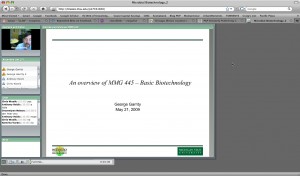An Open-Access, Standards-Supportive Publication that Rapidly Disseminates Concise Genome and Metagenome Reports in Compliance with MIGS/MIMS Standards: the Session Blog
Presenters: Oranmiyan W. Nelson
July 9, 2009 at 2:30 pm
Background
Dr. Nelson is currently completing his post-doctoral work at Michigan State University, in the Department of Microbiology & Molecular Genetics. He is also the production editor of Standards in Genomic Sciences (SIGS), an open-access e-journal of the Genomics Standards Consortium (GCS) established in September 2005.
Session Overview
Genomics and metagenomics describes the study of an organism’s complete genetic data set, with emphasis on sequence mapping. The former is limited to the study of organisms that can be isolated in pure culture, whereas the latter applies to an entire community of microbes in their native environment. Technological advancements have facilitated a data explosion; genomic maps are now being produced at a faster rate than the existing publication infrastructure can accommodate. The result is a loss of data, contextual metadata and annotation. Essentially valuable data is disappearing before it can be interpreted or see the light of publication.

Number of published journal articles per year relating to the complete genome sequences of bacteria and archea
SIGS is a GSC initiative to attempt to bridge this gap, by producing concise peer-reviewed reports that comply with MIGS/MIMS standards, in addition to operation procedures, commentary and review articles. Minimum Information about a (Meta)Genome Sequence (MIGS/MIMS) is a GCS initiative to expand on core reporting standards already established by the International Nucleotide Sequence Database Collaboration (INSDC). MIGS/MIMS is characterized by a standardized checklist that has been published in its entirety in Nature Biotechnology. SIGS will attempt to keep up with data production by offering an accelerated editorial revision workflow, where copy-editing begins almost immediately after initial acceptance.
The e-journal’s goal is to produce 600 publications by June 2011 (approximately 30 per month), by attracting internationally credible authors under a cost-effective model for an open-access journal.
A sample short genomic report was then described, in conjuction with MIGS/MIMS standards. The anatomy of a report included a abstract and introduction (a), genetic sequencing information (b) genome properties (c) and comparisons with previously sequenced genomes (d). Lastly, conclusions and references (e).
References
July 13, 2009 Comments Off on An Open-Access, Standards-Supportive Publication that Rapidly Disseminates Concise Genome and Metagenome Reports in Compliance with MIGS/MIMS Standards: the Session Blog
Moving from Paper Production to Online Open Access with Open Journal Systems: The Session Blog
Presenter: Laura C. Botsford, Assistant to the Editor, Canadian Journal of Sociology, University of Alberta
Time: 4-5 pm, July 9th, 2009
Place: SFU Harbour Centre, Sauder Industries Room 2270
———————————————————————————————
Session Overview
Background
In the early days of the Canadian Journal of Sociology, a great deal of manual work was required to print the journal, from getting galleys to making notes in the margins, to cutting to appropriate size and pasting onto paper sheets, etc. The editors of the journal soon realized that they were susceptible to too many external factors and decided to move to typesetting and a mainframe computer. While this newer technology had its advantages, there were many codes to learn and all that could be seen was the markup language; not the end result. The lack of a preview often created surprises for the editors when the pages were printed. Eventually technology progressed and the journal got some computers with What You See Is What You Get (WYSIWYG) capabilities– but they still had to go through the whole printing process. Dr. Kevin D. Haggerty took over as editor in 2007 and within a few months, decided to go electronic and open access with the journal. While everyone involved had many questions and qualms, they ultimately ‘took the plunge.’
Related Information Re: Printing Processes
Click here for a printing press demonstration on Youtube
A more recent version of the printing press:
(source)
Using the Open Journal System (OJS)
Moving to electronic publishing has reduced many of the traditional problems involved with the printing process and OJS has features that are very helpful, such as its functionality for the second review– the system automatically generates a list of reviewers and filters out those who have already declined in the first review.
However, OJS still poses many problems for users, so patience and technical support is absolutely critical.
Session Questions
Comment: There are currently seventeen journals running on the University of Alberta website, but the Canadian Journal of Sociology has been the most conversive, and questions have really pushed the development of OJS forward.
Question: What was the driving force to move to online and open access? We were becoming aware of the new generation of scholars coming up, and they are expecting to see their info on the internet. Also, printing and mailing is becoming increasingly expensive.
Question: How many copies were being printed prior to moving to electronic form? Answer: 1000
Question: How has converting from print to open access impacted the finances of the journal? Answer: It was a subscription journal, but the journal has been anomalous. We had some money in the bank, and received money from aggregators who have continued to contribute. One of the reasons for moving to open access was that subscriptions were dwindling– libraries were declining because they were lacking space and funding.
Question: Any plans to digitize back files? Answer: Yes. We haven’t tried it yet, but are definitely planning to.
Question: What is your business model? How much does it really cost to run the journal? Revenue stream? etc. Answer: Revenue stream usually from the Social Sciences and Humanities Research Council of Canada (SSHRC) and aggregators, but we also had money in bank that was invested. We also benefit from non-monetary things that the university provides, such as office space, release time from teaching for Dr. Haggerty, etc.
References
Taking the plunge Haggerty, K.D. (2008). “Taking the plunge: open access at the Canadian Journal of Sociology” Information Research, 13(1) paper 338. [Available at http://InformationR.net/ir/13-1/paper338.html]
Related Links
July 13, 2009 Comments Off on Moving from Paper Production to Online Open Access with Open Journal Systems: The Session Blog
Maximizing the Reach of a Graduate Research Journal Through Open Source Tools and Social Media: The Session Blog
Presenter: Rajendra Bose
July 10th, 2009 at 3:30 p.m.
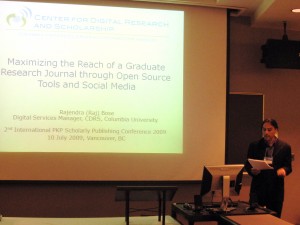
(used with permission from Raj Bose)
Background Info
Cultural Formations is an online journal (due to launch next month) that is open-access and peer-reviewed. The Center for Digital Research and Scholarship (CDRS) collaborated with Columbia University’s Teachers College to form Students for a Cultural Studies Initiative (SCSI). This project has grown to become more than just an online journal, using the concepts of Web 2.0 and Social Media as well as a research repository, Academic Commons.
As quoted on the Cultural Formations website, the journal-plus project has “…three integrated elements: an online journal of peer-reviewed articles, a blog for discussion of published articles and works in progress, and a wiki to serve as a “Wikipedia” of cultural studies and education.”
Session Overview
Graduate students at Columbia University and the Teachers College joined forces to form SCSI. Over the past year, they have worked hard to start a “journal-plus” – an online space that looks at cultural formations including youth culture, media, music, art, film and ethnicity, etc. Their goal is to not only publish research but to be accessible to the entire community, not just academic scholars. Along the way they were faced with significant challenges (examples include web design, technical problems with layout of the vastly different programs and challenges from having multiple partners with decision-making authority). They are however on schedule to launch their site next month. (Please stay tuned to this blog for the launch announcement!)
Services they hope to provide
- Publications – e.g. online books, journals
- Conferences
- Academic Commons
- Wikischolars
An example of what their website will look like:

(Used with permission from Raj Bose)
The goals of the Cultural Formations site are three-fold:
- authority of a journal
- immediacy of a blog
- what’s new and emerging in wiki format
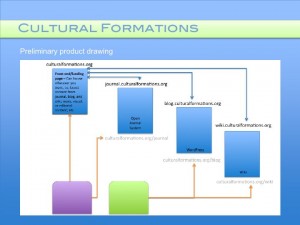
(Used with permission from Raj Bose)
The site is scheduled to launch in August 2009 at Culturalformations.columbia.edu (URL may change prior to launch).
Questions from the audience
1. Impressive. Will you open this up to the public as open source?
Yes, we are using all open access materials. The idea is to share it with the rest of the community, Users may have to connect with us to get a user profile as it may be too expensive to allow it open to all users at once. There likely will be a basic free level, and we may charge for some of the more advanced functions. We feel the site will have longevity with the article content/repository.
2. Is there a similar movement in other universities?
Yes, but the idea right now is to work with university presses and authors right here to get the right agreements.
3. Is there going to be any co-ordination with other groups?
Already there are 50-100 student journals with OJS [Open Journal System]. You especially want this system for longevity when a student group starts to fade out, this will help. The university hosting this site will help keep those groups up and running.
4. What about groups with other levels of education and how this may be used?
This idea is not a typical journal, but the idea to connect a blog and a wiki so that other members of community can join or help is amazing and very inclusive. Because of this, there will only be a light peer review. They partners want to keep this as open as possible.
Related Links
Center for Digital Research and Scholarship (CDRS)

Open Archives Initiative Object Reuse and Exchange (OAI-ORE)
July 10, 2009 Comments Off on Maximizing the Reach of a Graduate Research Journal Through Open Source Tools and Social Media: The Session Blog
Creating an Open Access Journal; A Medical Students’ Prospective: The Session Blog
Presenters: Steven Andrew Plato II and Andrew James Wyman (remotely), David Solomon in-house
July 10th, 2009 at 3:30 p.m.
Background info
Steve Plato and Andrew Wyman are third-year medical students from Michigan State University who saw a need in the literature for a dedicated place for medical students to publish their work and founded The Medical Student Research Journal (MSRJ) in 2007. They are due to publish the first issue this fall.
Session Overview
The session got off to a rough start with a few technical difficulties (due to new too-loud speakers in the meeting room at Simon Fraser University). The students gave the presentation from their editorial room in Michigan via Adobe Connect Pro. They use this to connect with the many geographically diverse authors/editors/faculty associated with their journal. The image, Powerpoint and voice are very clear. This is an exciting software tool for all distributed learning models.
The students went on to explain that they started the journal to fill a gap. Most students have extensively researched their chosen field of specialty throughout medical school, but often do not know how or where to publish their work. Whereas 60-100% (depending on specialty) of medical students matching to their first-choice residency stated they had extensive research in their field, the proportion of those that had published was as low as 35% for some specialties. MSRJ is peer-reviewed, authored and edited entirely by medical students which they hope will be the go to journal for medical students to publish that work.
This project was started at the Michigan State University but the creators hope to reach medical students throughout the US as well as internationally. THE MSRJ uses Open Journal Systems (OJS) and Creative Commons licencing to ensure communication and availability of publication to all medical students. This project is similar to a one started a few years earlier by the same institution (MSU) in a graduate biotechnology course (see session blog from this conference) however on a much quicker timeline, around 28 days!
OJS has been very helpful for the med students as it helps to facilitate their multi-location system, has low overhead and allows them rolling publication with minimal delays. They also like the management tools that help to guide novice editors (reminders/checklists) to make the process simple. OJS also tends to being in a larger readership.
Faculty
Faculty assure quality peer-review. Students are trained by faculty in critical appraisal, principles of scientific writing and academic integrity. They are also able to review a mock article and can compare their reviews to similar good and poor examples to learn to become a better reviewer. Faculty also provide guidance on sustainability and establish good practice in mentees (more hands-on and one-on-one time with people who know the literature the best). The students all go through an online training module, from the Annals of Emergency Medicine, prior to starting as well.
Usually one faculty will mentor 3-4 students per article. This helps less experienced reviewers in specific fields. They also provide feedback and guidance on where a review may be lacking. Students can then re-review and submit, then the editor decides to accept, accept with revisions or decline the article.
Sustainability plans?
Many other journals before this have struggled with longevity. MSRJ have instituted a student replacement policy (juniors that will take over when the current editors are done) and training sessions for editors which serve as quality control. In addition a letter from the Dean will be placed into the student file for encouragement to participate and to continue the job. Faculty are also rewarded by recognition in published material as well as a formal letter to their respective Departmental Chair. An annual report with statistics on publications is also planned for accountability
Finances?
The students plan for this journal to be a free or very low cost venture. All labour is by students or faculty. There is a minimal cost for the website host, however their major cost is copyediting, which they hope will be eliminated by using university resources. XML generation is also a marginal expense as is website development.
Benefits
The students feel the benefits are quite clear. They build experience in scientific writing and editing as well as get a head start on publications for their career. It is also strongly beneficial for those students doing research outside academic centres such as rural and distributed sites.
Since Open Journal System (OJS) has become a forerunner in educational resources, many other institutions have been able to start similar projects, with one just ready to launch this fall here at my home institution, UBC. The UBC Medical Journal will provide medical students with a forum to publish their research work that previously had no definitive place for publication.
Questions from the audience
1. I understand medical school is an intense experience. Do you have to sacrifice other parts of the educational experience to participate?
While it is true it is intense, but one thing about medical school is it does allow you to do things outside of school. Most students are involved in extracurricular activities already and 60-100% already involved in research. There will be some sacrifice, but usually that would be less time for research projects (i.e. one instead of two). The time intensity of the reviewer part of the job is not significant. Students only review one article at a time. There is a base here already, but it does take away time, hopefully that time is well spent.
2. Are the training materials you used publically available?
Yes they are online in the Annals of Emergency Medicine Journal. They have a great online flash based training process that we used.
3. Do you plan on only accepting articles from MSU or do you plan to open the journal up to other universities?
This journal will be open to med student/residents around the world once it is started. MSU is unique in their distributed plan in the states. Right now, you can submit from anywhere, but we hope to expand reviewers across the country.
Related links
The Medical Student Research Journal
Andrew@msrj.chm.msu.edu
Steven@msrj.chm.msu.edu
dsolomon@msu.edu

July 10, 2009 Comments Off on Creating an Open Access Journal; A Medical Students’ Prospective: The Session Blog
Enriching Digital Citation Networks using Web 2.0 Principles: The Session Blog
Presenter: James Williams, Session Abstract

July 10, 2009 at 4:30 p.m.

Photo taken at PKP 2009, with permission
Background
James Williams is Manager, Information Systems at the eScholarship Research Centre at The University of Melbourne (http://www.esrc.unimelb.edu.au). His background is in Computer Science and Linguistics. James’ work focuses on eResearch and eScholarship, archiving and print on demand.
Session Overview
This session was a technical session, which laid the context and groundwork for a plug-in aimed at leveraging the network for citations. This session also highlights that some of the features of this plug-in are about to be implemented in the Referral plug-in coming with OJS 2.3. The author is planning to take his plug-in further by building on the work that has been done with the OJS Referral plug-in.
The context and groundwork included: Scholarly Contribution and Statistical Measurement; Bibliometrics – the h-Index and Journal Impact Factor; Indexes, Citators, Aggregators, etc.; What is Scholarship? What is Significant?; Developing Online Research Support Infrastructure; Scope – Scholarly Publishing and OJS Development. The key driver behind the paper had been to lead up to a plug-in which could capture and expose citation data, though this has been, to a certain extent, scooped by the Referral plug-in in the coming OJS 2.3. So OJS created a “heart broken Australian”, though one who is expected to make a full recovery.
In Australia, extensive dialogue around the measurement of academics’ scholarly research. Much of this is controversial. One key measure discussed is citation measures. Two citation measures come up in these discussions: the h-index and the journal impact factor. Many questions have been raised about this and attempts made to improve these measures, but questions remain about the extent to which they can be relied upon. The h index is from a paper by Hirsh, (2005). Crudely, it is the average number of citations that an author’s publications achieved in a year. Though its calculation is more complex than this.
Further problems with citation measures include statistical considerations with these measures which vary greatly between disciplines, so citations counts can vary greatly for statistical reasons. The source of these citations is the different indexes (Scopus, ISI Web Of Science, PubMed, Google Scholar) though each of these measures citations differently.
So, in general, what is needed is to develop intelligent digital citation networks, increase the discoverability of significant research contributions, harness the footprints caused by active network behaviour, provide greater statistical detail for transparency, and surface this information as much as possible for richer bibliometric reporting.
So, more specifically, what is needed is to track referrer information where it’s available: referring website/link/journal, date of referral and number of incoming hits from each referrer. As each referring URL, site, or journal is detected, it then becomes a known information source – an external, digital citation. We then surface this URL, site, or journal on the originating journal. Users of our (originating) journal, unaware of the external citation, can then find other people referring to this resource, and so, the networked community expands, develops, and evolves. This is the intent behind our planned digital citation plug-in, but which, as previously mentioned has been partially scooped by the Referral plug-in in OJS 2.3. So we are going to look at the Referral plug-in and talk further with PKP about this and build on the work that PKP has done.
Session Questions
Q. I’d like to know more about the h index?
A: Hirsh (2005) and others have expanded this. Peter Jascoe has also written a paper on this
Q. What software should use would where citations need to be checked in the publication process? How can we auto check and fix citations?
A. For OJS, the Resolver plug-in will help. L8X could also help.
References and Related Links
eScholarship Research Centre, University of Melbourne
Hirsh, J.E. (2005). An index to quantify an individual’s scientific research output. Retrieved on July 12, 2009 from http://www.cs.ucla.edu/~palsberg/hirsch05.pdf
Top Scholars in Computer Science, as calculated by the h index
What is Web 2.0? (includes translations in Chinese, French, German, Italian, Japanese, Korean, Spanish)
July 10, 2009 Comments Off on Enriching Digital Citation Networks using Web 2.0 Principles: The Session Blog
The Latest Developments in XML Content Workflows: The Session Blog
Presenter: Adrian Stanley, Session Abstract
July 10, 2009 at 11:00 a.m.
Background
Adrian Stanley is the Chief Executive Officer for The Charlesworth Group (USA). Prior to this Adrian worked for 4 year as Production Director for Charlesworth China setting up their Beijing office. The Charlesworth Group offers cutting edge automated typesetting services, as well as Rights and Licensing opportunities for publishers in the China market. Adrian is an active committee member for the SSP (Society for Scholarly Publishers), The Association of Learned and Professional Society Publishers (ALPSP North American Chapter), the Council of Science Editors (CSE), as well as working on a key project with the Canadian Association of Learned Journals; he has 20 years experience working in the publishing/printing sector.
Session Overview
This session was a technical session, yet one which tried to keep the technology basic and focused more on the benefits of the technology for the publishing process, particularly the benefits of XML. Charlesworth works with XML and XML workflows. Their aim is to support publishers. This session showcased their tools.
The benefits of using XML are the automation and time saving in the publisher’s workflows. But more fundamentally XML adds energy to data. The presenter took a short poem and showed it as text, then HTML then XML. The change in the poem was less how it looked than what it now was. In XML, it now had substantial additional information encoded with the poem.
Benefits of XML are numerous, adding more information and data about an article, data that is both machine and human readable. The presenter referred to the excellent pre-conference workshop in the PKP 2009 conference by Juan Pablo Alperin for further information on XML.
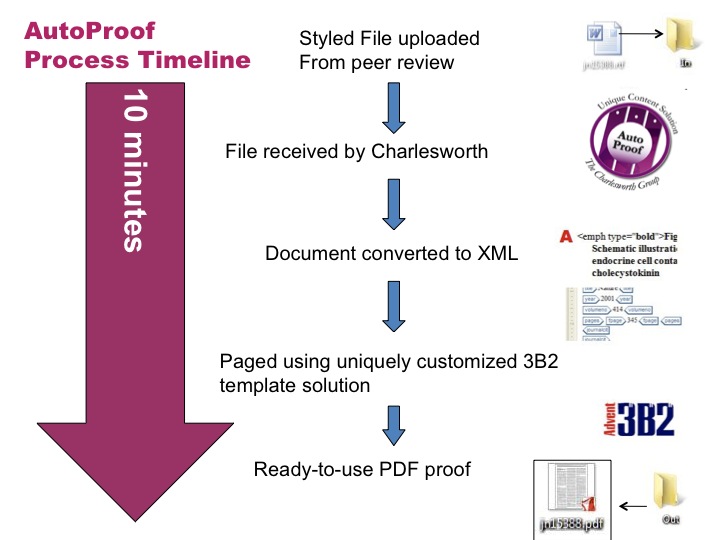
Image taken from presenter's presentation at PKP 2009, with permission
AutoProof Process Timeline diagram highlights the 10 minute process that Charlesworth’s AutoProof performs. It takes a styled file, converts it to XML and then outputs it in production ready PDF format. Charlesworth provides some Microsoft Word macros that help apply tagging and styling, to prepare documents in Microsoft Word for import to this process and ultimately XML. The presenter took us through this process showing each stage.
The presenter then showed the Online Tracking System that allows a view into each stage in the AutoProof process. From one screen, the publisher and editor can run the entire publishing process.
Next some examples of the many other types of AutoProof publications that are possible were shown. It’s not just journals e.g. program and abstract meetings, ebooks, dictionaries, etc can be handled. As long as files coming to AutoProof are structured, many types of documents can be used and created. So what AutoProof is doing is simplification and reduction of time in the workflow process, using XML at its core.
In addition AutoProof supports incorporating XML into the PDF, to make PDFs more readable and searchable. Storing the metadata in the PDF file (using XMP) could make it much easier to import a large collection of PDF files into a reference manager. XMP combines XML metadata within the PDF file. The presenter showed a sample XML Packet (XMP) page.
Other applications and developments with XML are also possible including auto generation of table of contents and Index, author proofing of link to PDF form XML, creating XML in multiple DTDs (document type definition), etc.
So in summary the goals of AutoProof are to enhance publications, customize how much or how little the publisher wants to do with XML, provide integrations with other systems and provide the basis for further developments e.g. authoring templates. Lastly, the presenter showed an example of OJS journal using AutoProof. Every reference automatically picked up the DOI (Digital Object Identifier) and automatically creates web links to the references.
Session Questions
Q: How much of publishing workflow did the James Journal use?
A: The James Journal allowed forward and backward linking, see the references in this James Journal article. They used most of our services; most fundamentally we created the XML. Because they used a lot of our services they were able to publish this magazine with a part-time editor.
Q: What about integration with OJS?
A: So we are working on creating integration with OJS
Q: What are the costs?
A: Broad range, depending on services that you need. The important point however, is to start to work out how much the alternatives of using your staff time is in fact really costing you. That is where we can help you make savings by significantly reducing the amount of staff time you need to dedicate to the publication process.
References and Related Links
Charlesworth Group launches new open access OJS journal
DTDs (document type definition)
DOI (Digital Object Identifier)
July 10, 2009 Comments Off on The Latest Developments in XML Content Workflows: The Session Blog
Establishing a New Open Access Journal in Africa: The Case Study of the African Journal of Primary Health Care & Family Medicine (PHCFM): The Session Blog
Presenter: Pierre de Villiers
July 10th, 2009 at 2:00 p.m

(Used with permission from Pierre de Villiers)
Webstream
Background info
As a new discipline to Africa, Family Medicine needed a forum to communicate scholarly work throughout Africa. Ten countries in the neighbouring area of the Sub-Sahara joined together and through academic support and affiliation with well known academic associations started a new journal, The African Journal of Primary Health Care & Family Medicine (PHCFM). Their mandate was to ensure 20-30 publications were accepted and published per year. It delves into family medicine for the primary health care giver using African context. They use Open Journal Systems, and Creative Commons licence to ensure accessibility over the ten participating countries. They have multiple citations in Google scholar. The editor-in-chief is Professor Gboyega A Ogunbanjo from the University of Limpopo, South Africa. He is a specialist family physician.
The journal is mainly supported by the Flemish Inter-university Council (VLIR), a department for University Cooperation for Development, through the project VLIR-ZEIN 2006 PR320, but also has local support from Africa as well.
View Participating Partners in the new African journal, PHCFM in a larger map
Session Overview
Dr. de Villiers starts this session describing why he started this new journal. He has been the editor of the South African Academy of Family Practice/Primary Care journal (SAAFP) for the past ten years (the journal has fifty years of experience). Since that time, South Africa (SA) has made family practice into a specialty and now there is a great emphasis on primary health, care not only in SA but all over Africa.
He recognized many problems in communicating the knowledge of Family Practice in Africa:
- There were no full African journals at the time
- Most research was published in non-African-run journals
- It was difficult for African scholars to get published
SAAFP went online in 2005 as the first journal in Africa to do so. Open access to the journal started in 2006 and saw a dramatic effect on increased submissions to this journal as well as those articles sent to NEJM. Submissions were too numerous by far to publish solely in SAAFP and the need for a new journal was finally realized.
Once Dr. de Villiers decided to start this journal (PHCFM), he had standards he needed the journal to commit to.
- Published in English
- Peer reviewed
- Open access
- Onlne – for global visibility
- Rolling publication – articles could be published as they became available
- DOI – Crossref
- Ability to print on demand at end of every year
- Copyright – would use creative commons licencing to keep it open
- Credible Editorial board – Large African component as well as international made for highly visible editors
On November 18th, 2008, the official launch was in Kampala (picture above). Since then, the statistics on the journal have been staggering.
- Submitted 74
- Published 16
- Edited and accepted 11
- Declined 27 (36%)
- In-review 15
- Days-to-review 55, and days-to-publication 126
People are reading this journal, mostly from SA but a strong component are from Nigeria and the rest of the developing world. The website has registered over 2000 unique visitors this year, with 3.42 visits/person. People like what they see and 77% of people come back through internet bookmarks.
When Dr. de Villiers asked, what did we do right? He believes he had many good things working for him:
- Credibility of his editorial board – this gives the author/reader trust to submit articles as well as to use the journal as a reference tool
- Quality of editorial process (maybe too good with 36% rejection rate?)
- Sponsorship of funding and support
- OJS/online availablity
- Professional publishing service
This journal was endorsed by the World Association of Family Doctors (WONCA) at their 2009 conference and has been indexed in African Index Medicus. African Journals on Line (AJOL) will be accepting the journal this year, and they hope to be indexed in PubMed next year.
He states some of the challenges he has seen as well as anticipates seeing are:
- Need for continued funding (>5 years)
- High rejection rate
- Author support may be needed
- Additional funding to publish more articles (costs 500 euros per article)
When talking about the future of what he thinks the journal needs to do to stay visible and expand:
- Accreditation – needed from the Department of Education in order to get more funding (their application is being considered now)
- Continuing Professional Development credits needed
- XML publishing (under review)
- Thesis abstracts will start to be published July 2009
- French abstracts/articles will be started to help readership
Related Links
July 10, 2009 2 Comments
From Pedagogy to Androgogy: Using OJS to Immerse Students in Peer-Review Publishing: The Session Blog
Original Abstract Title: An Online, Open Access, Student-Authored and Peer-Reviewed eJournal in Biotechnology
Presenter: George M. Garrity
July 10th, 2009 at 9:30 a.m.
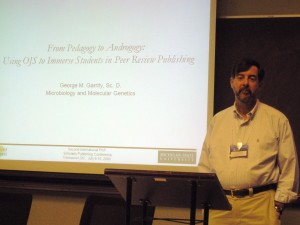
(Used with permission from George Garrity)
Background info
A course (MMG 445 Basic Biotechnology) taught at Michigan State University by George Garrity has been a leader in student open access knowledge publication. The curriculum ensures its students learn the rigorous method of peer review in their field by becoming both authors and reviewers. The course and website follow Creative Commons licensing and pay particular attention to intellectual property. The students hope to be published at the end of this course after surviving the said scientific methods of journal editing and learning about biotechnology to boot.
Session Overview
The session starts with Professor Garrity describing a 20-year old course description that claims to deliver thoroughly out-of-date biotechnology topics and methods. You would think this would mean a zero percent class registration, but in contrast the class has been increasing in size every year and the university has placed a cap at 50 students! Word of mouth has ensured that this important course for all students is continued. Why is this course important you ask? Garrity goes on to explain that there are 5 essential elements students need to possess and are rarely taught in school:
- Curiosity
- Open to new ideas
- Problem solving
- Critical reading and listening skills
- Ability to express oneself clearly (written and verbal)
He continues on to describe what happens in the real world and skills you need to possess to become successful in your field:
- work on multidisciplinary teams
- be adaptable
- ability to acquire new skills quickly.
He shows how the course has changed over the 10 past years and how the course has come from a traditional lecture based series to a now completely virtual university with all lectures given online and students able to blog/chat online with each other and professor at the same time. He has instituted a blog for students to ask questions about the given weekly lecture (and this is the class participation mark). The students do not get away with mindless, redundant questions either. They will get thrown back to the students to revise.
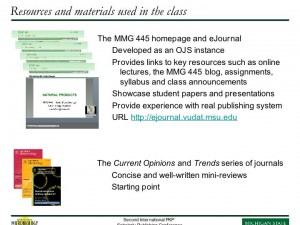
(Used with permission from George Garrity)
The course is structured into 4 assignments:
- Review paper (topic of their choice from Current Biotechnology) 30%
- Student Reviewer (4 other student papers) 30%
- Presentation of their paper 30%
- Class Participation 10%
Garrity and invited expert guest lecturers ensure that the whole process is valid and conforms to proper methodology. They also ensure that students are true to their said interests and get the work authored and reviewed in a timely fashion. The whole process has to be completed in one academic semester (13 weeks). There is a 70% acceptance rate and students are held to high standards. He relates to the class the importance of publication and how the scientific community uses this process to communicate, gain recognition and as a tool of quality control.

(used with permission from George Garrity)
The student publications can be viewed online via the Open Journal System and have been thoroughly cited in Google scholar. These review article have been cited by other peer-reviewed articles multiple times, have been published by Elsevier and have been used in hiring interviews. Student Alumni have come back to class to give ringing endorsements of the reality of the class and well as to become teaching assistants or guest lecturers.
One of the biggest components is the no-tolerance policy on plagiarism which is painfully spelled out by Garrity in class and even goes on to tell the students how he will catch them. You would think this would turn students off of the idea, but he still gives examples of multiple plagiarized papers each semester.
As stated above the course goes beyond plenary sessions to include the above unique writing as well as faculty and student-generated online videos. They do this using Web 2.0 online programs (Adobe Connect Pro/Skype) which are similar to Jove (Journal of Visualised Experiments). Please see the YouTube tutorial below for an example of how Adobe Connect Pro works. These are easy to use and cheap to install in the classroom.
Questions from the audience
Most questions centred around plagiarism and how he could detect the multiple examples.
The shared techniques from simplest to complex were:
- multiple different fonts in a paper
- multiple writing styles in a paper
- undergrad level English/grammar forging into graduate level writing and then back again
- use of technically perfect writing, however strung together in such a way that it made no scientific sense
A specific technique he used centred around an “anchoring” word which is a word that shouldn’t be used commonly that appears. He places this word with three or four surrounding words in google and tries to find wrong citations or mis-citations. All evidences of plagiarism is reported back to the Academic Council and Dean.
Notable Accomplishments
The eJournal continues to increase in circulation with >92,400 downloads to date (Source).
Seven student articles have been downloaded > 2000 times and 23 papers over 1000 times (Source).
The eJournal has been chosen as the first place recipient in the 2007 MSU-AT&T Faculty-Staff Awards for Instuctional Technology.
Related Links
Scientific Writing Reference texts

July 10, 2009 1 Comment
The OJS Community: who is doing what with OJS: The Session Blog
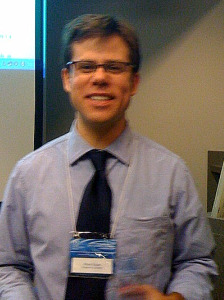
Brian Edgar at PKP 2009. Photo by C. Gratham
Presenter: Brian Edgar – Stanford University. Bio
July 10, 2009, 10:00-am-10:30 pm. SFU Harbour Centre. Rm 7000
Session Overview
Mr. Edgar presented the preliminary results from a survey of over 1,000 OJS editors around the world. The goals behind the survey were to gather information about who is using the journals, where they are located, and to gain a sense of their funding models as well as what motivates them to do this work,
While the data analysis is still in the preliminary stages, Mr. Edgar presented some of the survey results and commented on a number of the findings as follows:
- South America, Europe, and North America (in descending order) accounted for 75% of the journals
- Almost half the journals were in the Social Sciences with Health Sciences and Technology and Engineering the next most common topic areas
- More than half the journals were sponsored by academic departments and another third by scholarly associations
- The rate at which the journal accepted articles was quite variable with roughly equal numbers distributed across all the acceptance rate bands
- A very high percentage of the journals used editorial and double blind review procedures
- In most of the journals, the editor is personally responsible for copy editing, layout, and proofreading
- But it is not a full-time job for the editors. In 80% of the journals, editing requires less than ten hours per week.
- Most of the journals reported small (or zero) expenses and revenues. However, a small percentage reported more than $50,000 in both. Mr. Edgar commented that these zero expense journals seem to indicate a new model for journal publishing becoming possible
- For those journals that generated revenue, it mostly came from institutional funding, followed by subscriptions, and then from advertising
- Most of the editors were motivated to do their work due to a desire to provide new knowledge and a service to the community and not for financial benefit
- While 83% of the journals qualified for inclusion in the Directory of Open Access Journals (DOAJ), only 22% actually were included
- Around 40% of responders continued to produce print journals
Questions and Audience Comments
A lively discussion ensued following Mr. Edgar’s presentation. Some of the key points are as follows:
- While the data analysis is still preliminary, they hope to have a more complete analysis by the fall of 2009.
- One audience member asked how many of the OJS journals were included in the ISI. The original survey didn’t ask about inclusion in the ISI, but they did ask about indexing.
- There was considerable discussion about why the number of OJS journals in DOAJ is small. One possible explanation is that the DOAJ has a big backlog in evaluating journals for inclusion, so it may be possible that the number of OJS journals in DOAJ will be increase as the backlog is cleared.
- There was also much discussion about those institutions reporting zero costs. There are real costs: servers, people’s time, cost of producing the knowledge, etc. But some felt that those costs are rightly viewed as a part of the operating costs of the university and it may be legitimate to not include them specifically in the journal cost. On the other hand, some people need to be able to put a time/cost as part of their justification to create an OJS journal, and they would like to see those costs broken out. An audience member pointed out that the data collected (e.g. hours per week that editors spend on the journal) can be converted to generate this data.
Related Links
July 10, 2009 2 Comments
Towards A New Future for Journal-Article Publishing: The Session Blog
When: Friday, July 10, 2009
Room: Main Concourse – Fletcher Challenge Room 1900
Time: 9:30 am – 10:30 am
Presenter: Frederick “Fred” Friend
Fred Friend studied history in Kings College, London. Next, he obtained a post graduate library qualification at the University College in London. Fred’s library career has spanned from Manchester University, to the University of Leeds, to the University of Nottingham and finally at University College in London. He currently holds the title of Honorary Director of Scholarly Communication at the University College in London. He is an OSI Open Access Advocate and a JISC Consultant.
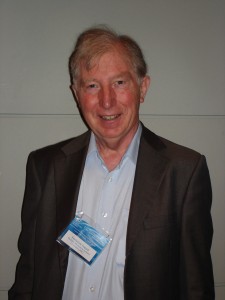
Fred Friend (source: Photo taken by Helen Szeto)
Session Overview:
Friend is here today to discuss the future of scholarly journal publishing with the movement towards the Open Access model. He begins the session by letting the audience know that the publishers in the UK are saying Open Access will destroy scholarly publishing. He continues by listing the assumptions that the publishers have. Some publishers see Open Access as a threat, while others see opportunities in the new model. Many publishers want the change in model to support rather than weaken journal publication. Publishers put the emphasis on the quality of the journal, while researchers put the emphasis on the article. They want to see public money to help increase publication. Friend asks the questions, “What kind of business models can be made viable in the future? Which models will enable high and effective use of published research?” There are large areas of agree and disagreement.
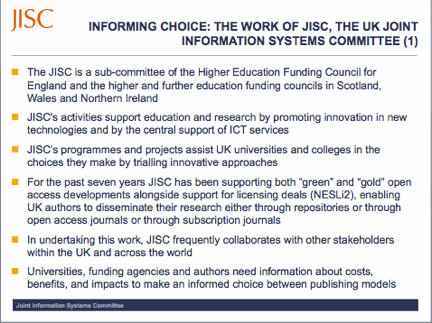
(Source: slide courtesy of Fred Friend)
This is where the Joint Information Systems Committee (JISC) comes into the conversation. It is a national committee in the UK that provides universities and researchers with information that they need in order to make the right choice. JISC is a strong supporter of open access and want to help maintain the existing model. They want to help promote innovation especially in helping universities decide which are the best innovative approaches. JISC supports both “green” and “gold” open access development alongside support for licensing deals. They want to collaborate with other stakeholders of scholarly journal publishing within the UK and world. Friend is here today to see JISC have more collaboration with the Public Knowledge Project.
The one key factor about providing information is the choice about cost and impact factor. JISC commissioned a report on the economic implications of alternative scholarly models. It also looked at how it would help the UK economy. Findings from the report showed that the UK benefited from moving towards either a self-archiving model or the gold Open Access model. It can get very fast returns by moving top open access (either green or gold). The Netherlands and Denmark have made similar reports. JISC also examines how much it will cost for institutions to switch models. They are trying to work with publishers on offering authors a choice between copyright and licensing.
Many policy statements in Europe have supported Open Access. Collectively, the European Union committed to an Open Access policy research funded through FP7. Local European institutions are considering how to manage these Open Access changes. There is stronger interest in gold Open Access in Europe than in the United States. Globally, countries with newer growth economies and less established publishers do not appear to be more advanced in Open Access developments than ones with established economies.
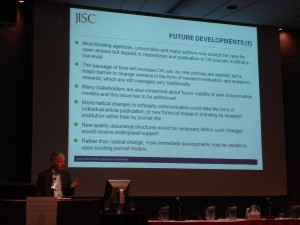
Fred Friend Presentation (Source: Photo taken by Helen Szeto)

(Source: slide courtesy of Fred Friend)
In future developments, Friend believes that there has to be a lot more in advocacy. Many researchers are concerned that their favourite journals will disappear. Fred says that academic journals will not collapse because of their importance to the research community. He believes their survival will come through changes in the repository. The academic community will take more control over the research dissemination process while publishers will act as service providers. Changes will happen, there will be variations and hybrids of new and old models. There will not be one model that will be able to dominate such as the subscription model has.
Analysis:
Friend recognizes that changes will need to be made to the subscription model in order for scholarly publishing to remain. His presentation provides a positive outlook for publishers in a world with Open Access. Both models can survive together, but changes will need to be made by both. The key word in the presentation is “change.” Things cannot stay the same; changes will have to be made to the traditional scholarly publishing model. Friend encourages everyone to go out and advocate for these changes. He believes that is the way to change the traditional model.
Session Questions and Answers:
1) One audience member said, “There are some green Open Access advocates who are very vocal about researchers …giving money to publishers when they can do it for less themselves. What is the cost of building institution repositories?
Reply: “Green Open Access is the best value for money of the 3 models, which is evident at the national level in the UK, Netherlands, and Denmark.” Friend doesn’t believe it will be the sole model used.
2) How do you get over the problem of having researchers demand certain journals?
Reply: Friend’s suggestion is to cancel subscription and buy gold Open Access journals.
3) Addressing the awareness of difference economies.
Reply: Friend says that charges to each model are based on their cost in the current system. He thinks that the costs will settle down over time. There will still be variations in models because there are different costs involved.
4) Friend comments on the voluntary labour in the publishing models. Voluntary labour is not free because mostly the institutions subsidize it. Problems occur with certain inefficiencies such as people not skilled in what they are doing. People are spending time doing something that someone else can be doing better.
5) What makes you think that the cost will be better controlled in the new models?
Reply: Friend believes that the academic community will control costs.
Related Links:
- Berlin 6 Open Access Conference: Frederick Friend
- Description of JISC’s scholarly communications work
- EFFECTIVE SCHOLARLY COMMUNICATION: JISC working for UK teaching and research presentation
- The European Commission’s open access policy
- Funding Policies and Research Access Round Table
- Google Scholar: Potentially Good for Users of Academic Information (2006)
- Open access advantages, opportunities, support: JISC and the UK parliamentary enquiry into scientific publications by F. Friend
- Negotiating Prices and Licenses for Networked Electronic Information by F. Friend
- Recommendations on paying gold OA publication charges in the UK are included in a working party report
July 10, 2009 Comments Off on Towards A New Future for Journal-Article Publishing: The Session Blog



